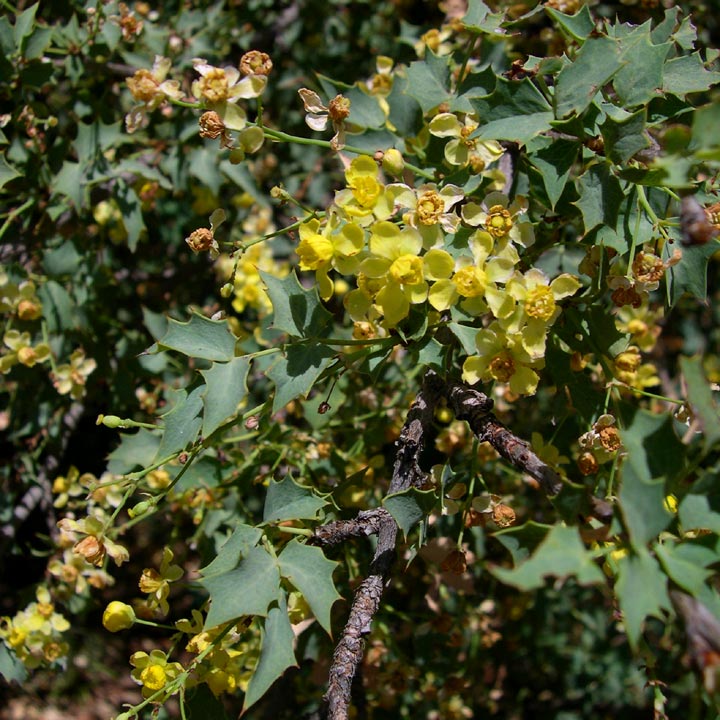|
Berberidaceae |
|
|
Herbs or shrubs [trees] , perennial, evergreen or deciduous, sometimes rhizomatous. Stems with or without spines. Leaves alternate, opposite, or fascicled, simple, 2-3-foliolate, or 1-3-pinnately or 2-3(-4)-ternately compound; stipules present or absent; venation pinnate or palmate. Inflorescences terminal or axillary, racemes, cymes, umbels (or umbel-like), spikes, or panicles, or flowers solitary or in pairs, flowers pedicellate or sessile. Flowers bisexual, inconspicuous or showy, radially symmetric; stipitate glands absent (except in Vancouveria ); sepaloid bracteoles 0-9; perianth sometimes absent ( Achlys ), more frequently present, 2- or 3-merous, or sepals and petals intergrading ( Nandis ); sepals 6, distinct, often petaloid and colored, not spurred; petals 6-9, distinct, plane or hooded; nectary present; stamens 6; anthers dehiscing by valves or longitudinal slits; ovary superior, apparently 1-carpellate; placentation marginal or appearing basal; style present or absent, sometimes persistent in fruit as beak. Fruits follicles, berries, or utricles. Seeds 1-50, sometimes arillate; endosperm abundant; embryo large or small; mature seeds elevated on elongating stalk in Caulophyllum. Berberidaceae presents several interesting biogeographic features. Achlys is disjunct from western North America to east Asia with few morphologic differences between taxa. Diphylleia , Jeffersonia , and Podophyllum , each with a single eastern North American species, exhibit wide disjunctions to east Asia. Caulophyllum has three species, one in east Asia and two in the flora. Vancouveria is endemic to northwestern United States with nearest relations to Epimedium Linnaeus (H. Loconte and J. R. Estes 1989b; W. T. Stearn 1938), an exclusively Eastern Hemisphere genus. Nandina , Berberis , Epimedium , and Podophyllum are cultivated. The perianth of Berberidaceae is commonly composed of three distinct types of organs, but terminology for the organs varies from author to author. In our treatment, we refer to the small, outer parts as bracteoles (collectively forming a calyculus); the large, middle parts as sepals; and the innermost parts, which are commonly nectariferous, as petals. Some authors have referred to the bracteoles as outer sepals and to the petals as staminodes.
PLANT: Perennial herbs, shrubs or small trees, glabrous or with unicellular hairs, occasionally glaucous. LEAVES: mostly petiolate, alternate, simple, trifoliolate or odd-pinnate, persistent or deciduous, often spiny, mostly exstipulate. INFLORESCENCE: 1-many-flowered, terminal or axillary, cymose, racemose, umbellate, or paniculate. FLOWERS: actinomorphic, hypogynous, perfect, often involucrate; perianth 3(-5)-merous; sepals distinct,often petaloid, (4-)6(-many), in (1-)2(-4) series; petals free, (4-)6(-9), in 2(-3) series; stamens usually as many as and opposite petals (occasionally more), in (1-)2 series; filaments sometimes expanded; anthers 2-locular, longitudinally dehiscent, or sometimes with narrow laterally-hinged valves; carpels 2-3, united; ovary superior, 1-locular; placenta solitary, parietal or subbasal. FRUITS: berries or indehiscent capsules. SEEDS: oblong, straight to slightly curved, sometimes arillate. REFERENCES: Laferrière, Joseph E. 2001. Berberidaceae. J. Ariz. - Nev. Acad. Sci. Volume 26(1). |
|

